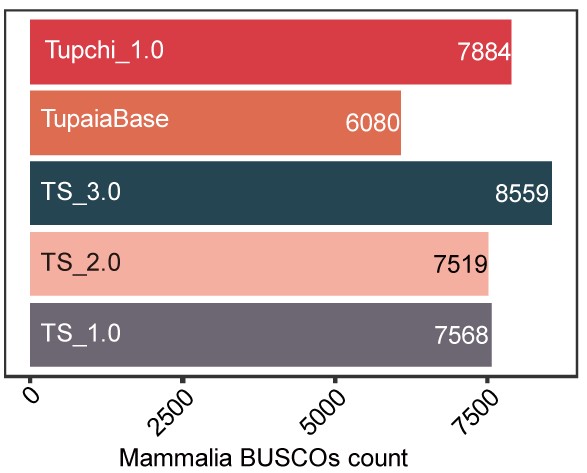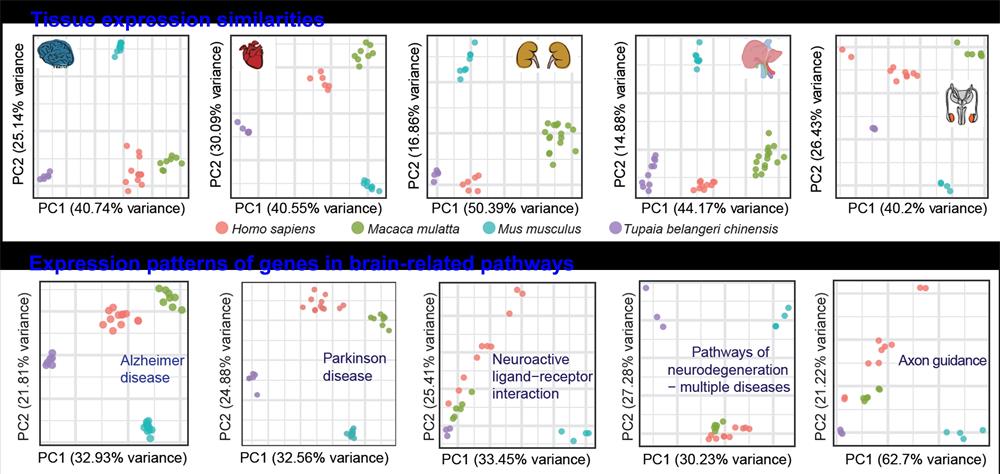A research team led by Prof. YAO Yonggang from Kunming Institute of Zoology of the Chinese Academy of Sciences, has reported a new version of Chinese tree shrew genome annotation and studied multiple genomic and transcriptomic characteristics of Chinese tree shrew, including gene family expansion, transcriptomic similarity across four species, and host immune response against virus infection. The finding was published in Zoological Research.
The Chinese tree shrew (Tupaia belangeri chinensis) is emerging as an important experimental animal in multiple fields of biomedical research, it has been used in studies including viral infections, cancer, myopia, visual cortex function, and neuroscience. Accurate genome assembly and annotation are crucial for understanding tree shrew biology and for developing disease models using this animal. Prof. YAO’s team successfully assembled the first high-quality genome of the Chinese tree shrew (KIZ version 1: TS_1.0) using high depth (~79X) short-read sequencing technology and the first chromosome-level tree shrew genome (KIZ version 2: TS_2.0) using single-molecule real-time (SMRT) sequencing technology.
This study improved the genome annotation of Chinese tree shrew by using transcriptome sequencing data of various origin. Researchers collected high-quality RNA-seq datasets of tree shrews from publicly available sources, as well as two ISO-seq datasets and 139 RNA-seq datasets newly generated in this study. They obtained a total of 53 298 newly annotated coding transcripts and 115 562 newly annotated non-coding transcripts and produced a relatively complete and reliable tree shrew genome annotation (KIZ version 3:TS_3.0).
Based on this comprehensive annotation, they explored the spatial expression and alternative splicing patterns of the tree shrew transcripts and characterized the orthologous relationships among tree shrews and other species. They also compared expression similarity across species and found that the species clustering patterns based on expression data from brain, liver, testis, kidney, and heart tissues showed distant divergence of mice from primates and tree shrews. Meanwhile, they identified 13 pathways showed greater protein sequence identity between tree shrews and humans than between mice and humans. The 13 pathways including neuro-related pathways such as “Parkinson’s disease” and “Alzheimer’s disease”. They also profiled the expression patterns of five pathways related to the brain and found that mice had a more distant clustering pattern than tree shrews with primates. Which shows that tree shrews are closer to primates than to mice at the transcriptomic level.
They further profiled the transcriptome patterns of host immune responses to viral infection using the TS_3.0 genome annotation, and found that newly annotated gene such as purine rich element binding protein A and tree shrew specific expansion STT3 oligosaccharyltransferase complex catalytic subunit B gene family were dysregulated upon virus infection, which may suggest important role during host immune response.
This study, entitled “Comprehensive annotation of the Chinese tree shrew genome by large-scale RNA sequencing and long-read isoform sequencing” (web link: http://www.zoores.ac.cn/article/doi/10.24272/j.issn.2095-8137.2021.272), was published in Zoological Research, Prof. YAO Yonggang are the corresponding author, YE Maoshen and ZHANG Jinyan are the co-authors in this paper. This project was financially supported by National Natural Science Foundation of China (U1902215 and 31970542.), Chinese Academy of Sciences (Light of West China Program xbzg-zdsys-201909), and Yunnan Province (202001AS070023, 2018FB046, and 202002AA100007).

TS_3.0 is the most comprehensive tree shrew genome annotation to date.

The tree shrews are more genetically similar to primates than to mice at the transcriptomic level
(By YE Maosen, Editor: YANG Yingrun)
Contact:
YAO Yonggang
yaoyg@mail.kiz.ac.cn

